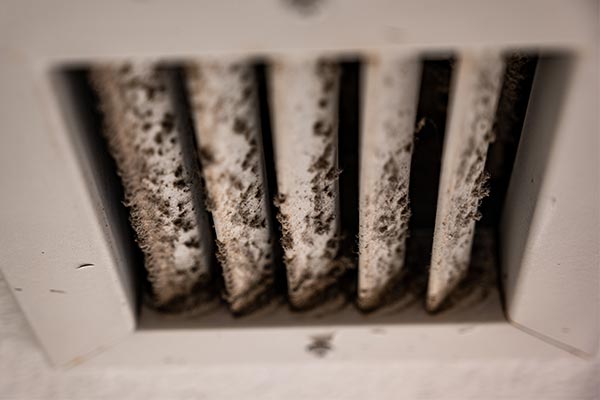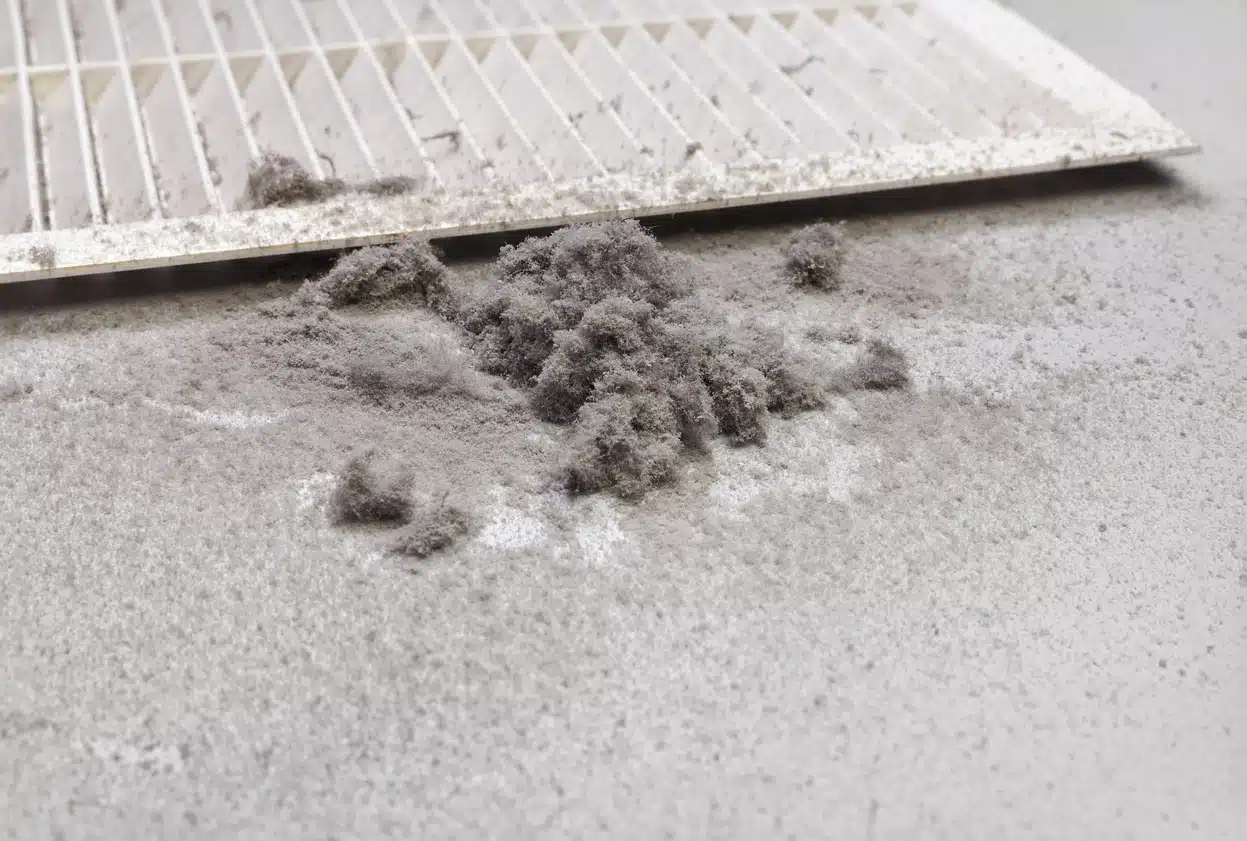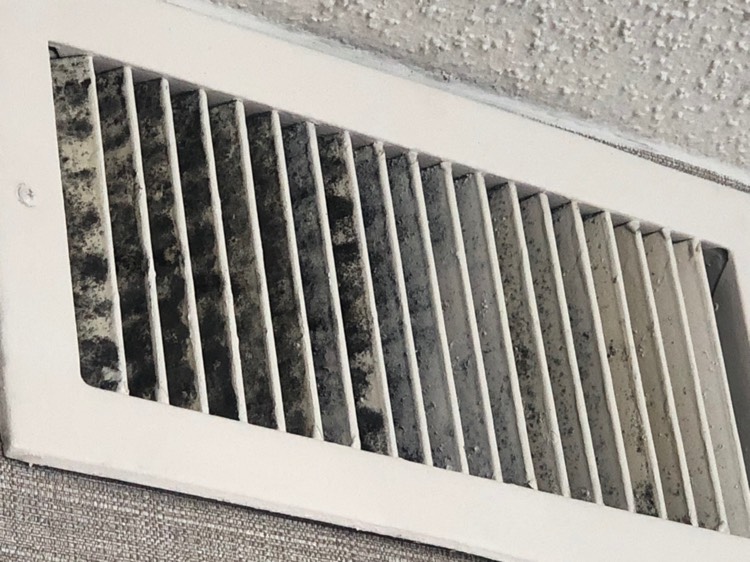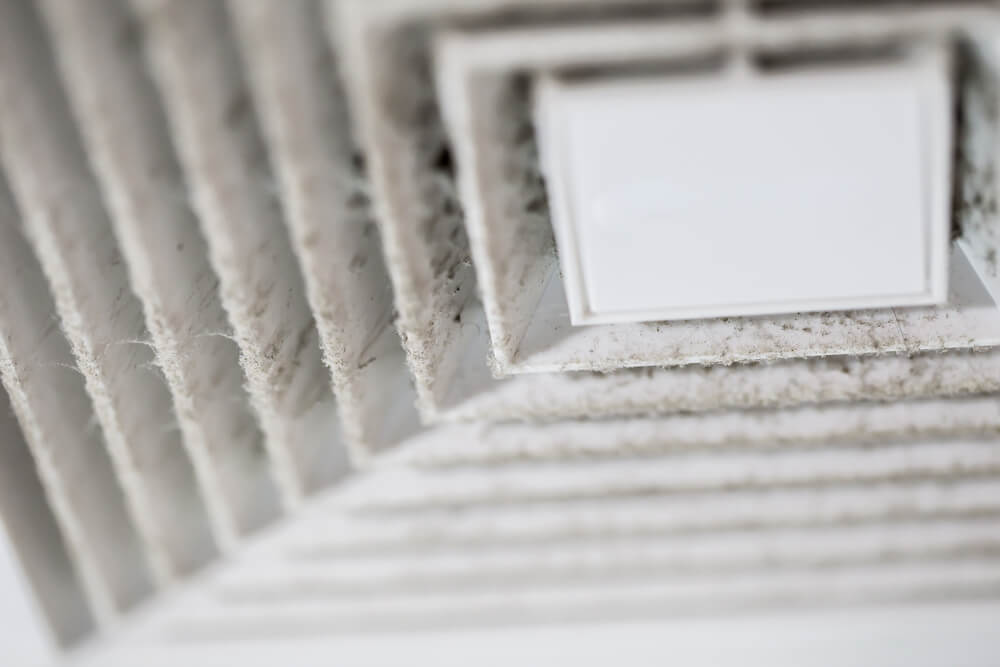To ensure the air quality in your home, paying attention to potential mold around air vents is essential. Mold can cause irritation, infection, and other health issues if left untreated. Also, they can reduce your HVAC system’s efficiency and airflow.
We’ve put together this guide to help you identify and prevent mold from growing in and around your air vents. We’ll discuss how to inspect for mold, clean and prevent it from growing, and what you can do if the problem persists. Let’s get started.
What Are Common Types of Mold In Air Vents?
Mold growth in air ducts is a common problem, as warm and moist air provides the perfect environment for mold to thrive. The most common types of mold found in air vents are:
1. Stachybotrys Chartarum (Black Mold)
Commonly referred to as toxic black mold, Stachybotrys chartarum is a mold species rarely found outside of specific environments. Such conditions include high humidity, low nitrogen levels, and no sunlight, with little to no competition from other molds. This toxic mold has recently been linked to Sick Building Syndrome in flood-damaged or water-damaged homes.
2. Aspergillus
Aspergillus is a mold that grows primarily on dead organic material, like soil or food. This mold is most commonly found in air ducts when the HVAC system has been left uncleaned for a long period. Its yellowish-green color and fluffy texture can identify it, and it is known for producing mycotoxins that can be harmful to humans if inhaled or ingested.
3. Ulocladium
Ulocladium is a mold commonly found in damp areas like bathrooms, basements, and air ducts with high humidity levels. It is usually dark brown or black and grows in patches or clumps. This mold has been linked to allergic reactions and asthma attacks, so it is important to have it removed if found inside the home as soon as possible.
4. Acremonium
Acremonium is a mold that often goes unseen inside homes because of its small size and long period of growth, which can take months or even years. It appears as a white powdery substance and is usually gray, pink, or white. At first, it’s compact and moist but eventually reaches maturity.
5. Mucor
Mucor is an aggressive mold that grows quickly in warm and moist environments, like air ducts with high humidity levels. It appears as white fuzz or cotton-like material and is known for producing spores that can cause allergic reactions and respiratory problems.

Toxic Signs of Mold On Vents
Several signs might indicate mold growing on your air vents, and you should act quickly to eliminate it. They include:
1. Black Dust On The Air Vents
For signs of mold presence, if you find black dust on the surface of an air vent which is difficult to remove, it can be a major indicator of black mold growth in the system. This occurs when spores inside the ducts get blown out and settle on vents as dust. Also, mold may grow directly on the vents due to the accumulation of dust and other particles that act as food sources. It is crucial to clean the visible mold on vents right away, as the spores could potentially be released into the air and cause health hazards.
2. Visible Mold Inside The Air Handler
For mold, furnaces and air handlers are prime locations as they tend to get very dusty (providing a food source for mold) and produce a lot of moisture. If you see any visible mold on the walls or ceiling of your furnace, inside the air handler, or any part of the system, it is a sure sign that you may need to take action. You should get an inspection done and consider replacing the unit if necessary.
3. Musty Smell Around The Home
If there’s a musty odor in your home, it could be an indication of mold growing inside the air vents. When this smell is present, you should check around your house for visible signs of mold and investigate the source further.
4. Brain Fog or Forgetfulness
In extreme cases, inhalation of toxic mold can cause people to experience brain fog and forgetfulness. Also, it can lead to more serious health issues such as respiratory irritation and asthma. If you or anyone else in your household is experiencing these symptoms, it’s important to have an inspection done to check for mold on the air vents.
5. Fatigue or Getting Tired Easily
Another common symptom associated with exposure to toxic mold is fatigue or tiredness. This can be due to breathing in spores which can cause toxins to enter your bloodstream, weakening your immune system and causing fatigue.
6. Allergic Symptoms And Itchiness
Mold exposure can also result in an allergic reaction with skin irritation, including rashes and itchiness. Also, people may experience congestion and sneezing, watery eyes, and coughing due to mold spores entering the lungs.
7. Upper Respiratory Tract Symptoms
In extreme cases, toxic mold exposure can lead to upper respiratory tract symptoms such as wheezing, chest tightness, shortness of breath, and difficulty breathing. If you experience any of these symptoms, it is important to seek medical help immediately.

How To Test For Black Mold In Air Ducts
Two major testing types are done to detect mold: a swab test used to check if there is any visible growth on surfaces and an air test that examines the air for mold spores.
1. Air Testing
Home inspectors and contractors will perform air testing when checking for mold spores in the air. This is done using a controlled volume air pump to take air samples. Generally, an air test is taken on each house level, plus one sample from outside as a reference point.
Once all samples are taken, the tests are sealed and shipped to a laboratory for testing. The results of this test will determine the number of mold spores per cubic meter in the air as well as the various species of mold that were discovered.
2. Swab Or Surface Tests
For visible mold, swab tests may be used instead of air testing. This means a home inspector or other professional is hired to take the sample and analyze it in a laboratory. Alternatively, DIY home mold tests can also be purchased, which include surface tests with a lab report.
When taking this type of test, there is usually a cotton swab or clear tape used to obtain the sample. This is then sent to a certified laboratory that will inform you of any mold species found and whether it is present. Unfortunately, this test doesn’t reveal how many spores are in the air.
Ways to Remove Mold on Air Vents
After detecting and identifying mold in your air vents, it’s important to take the necessary steps to remove it safely. Here are some easy-to-follow methods for removing mold around air vents:
1. Air Duct Cleaning
For thorough cleaning, the air ducts and vents should be professionally cleaned. Licensed HVAC technicians use specialized equipment to remove mold from your air ducts and vents, as well as any other contaminants such as dust, pollen, and debris. Using a professional-grade disinfectant is an effective way to eliminate mold from the air ducts and vents and prevent future mold growth.
2. Use a Vacuum Cleaner
Using a vacuum cleaner with a brush attachment is one of the easiest ways to remove mold from your air vents. Using a vacuum cleaner with HEPA filtration is important, as this will ensure that the mold particles are removed from your vents. Also, make sure to vacuum the area around your air vents, as this will help to prevent future mold growth.
3. Use a Cleaner
A mild cleaner such as white vinegar or bleach is another easy way to remove mold from your air vents. Spray the cleaner directly onto the affected area and wipe it with a clean cloth. Wear gloves and a face mask when using the cleaner, as this will help protect you from inhaling mold particles.
4. Use a Dry-Fog Machine
Dry-fogging is another effective way to remove mold from your air vents. A dry-fogging machine dispenses tiny droplets of disinfectant into the air to kill any remaining mold spores in your air ducts and vents. Also, the disinfectant will help to prevent future mold growth. Utilize a certified technician for this process.
5. Use an Air Purifier
Keep your air vents and other areas of your house clean and fresh with an air purifier. An air purifier is a device that uses filters, fans, or ultraviolet light to remove contaminants from the air in a given space. It can help capture mold spores before settling on surfaces around your home, including the area around your air vents.
Remember that an air purifier will not eliminate existing mold on surfaces but can help prevent future growth. When selecting an air purifier for your home, pick one with a HEPA filter, as these filters are designed to trap the smallest particles and spores from the air.

How To Prevent Black Mold in Air Vents
Here are some simple steps you can take to prevent black mold from forming around your air vents:
1. Regular Filter Changes
To reduce the amount of dust and other contaminants, you should change your air filters regularly. Once every three months is typically sufficient, but you may need to change them more frequently if you have pets or live in a particularly dusty area. Dust is a food source for mold, so minimizing it can stop the spores from multiplying.
2. HVAC UV Lights
Installing an HVAC ultraviolet light system inside your air vents will help kill any mold spores before they can settle and start growing. It also helps to keep other contaminants, such as bacteria and viruses, from forming, making your air cleaner.
3. Properly Drain The Air Conditioner
Mold can develop if the coils in your air conditioning system are not draining properly. Check your coils regularly and clear away debris or obstructions blocking the water flow. A professional should also inspect the unit annually to ensure it functions properly.
4. Insulate All Air Ducts
If you have any air ducts in unconditioned spaces, such as an attic or basement, you should make sure they are properly insulated to prevent condensation from forming. This will stop the excess moisture build-up in the air duct system, which can foster mold growth.
5. Plumbing Leaks
Check for any plumbing leaks that may leak water into the air vents or nearby areas. This could signify a bigger problem and should be fixed immediately to prevent mold from forming. Additionally, if your home is prone to flooding or receives heavy rainwater, ensure to ventilate the area properly to reduce moisture levels.
Conclusion
The above information makes it easy to understand why mold around air vents is a serious issue that should be addressed promptly. Molds can cause numerous health problems and damage your home’s structure, so it’s important to remain vigilant about identifying, removing, and preventing molds from forming near your air vents.
With proper maintenance, thorough cleaning, and effective ventilation systems, you can keep your home safe and ensure your family’s air quality remains healthy. Don’t wait until it’s too late – take action now to protect yourself from mold around air vents!


